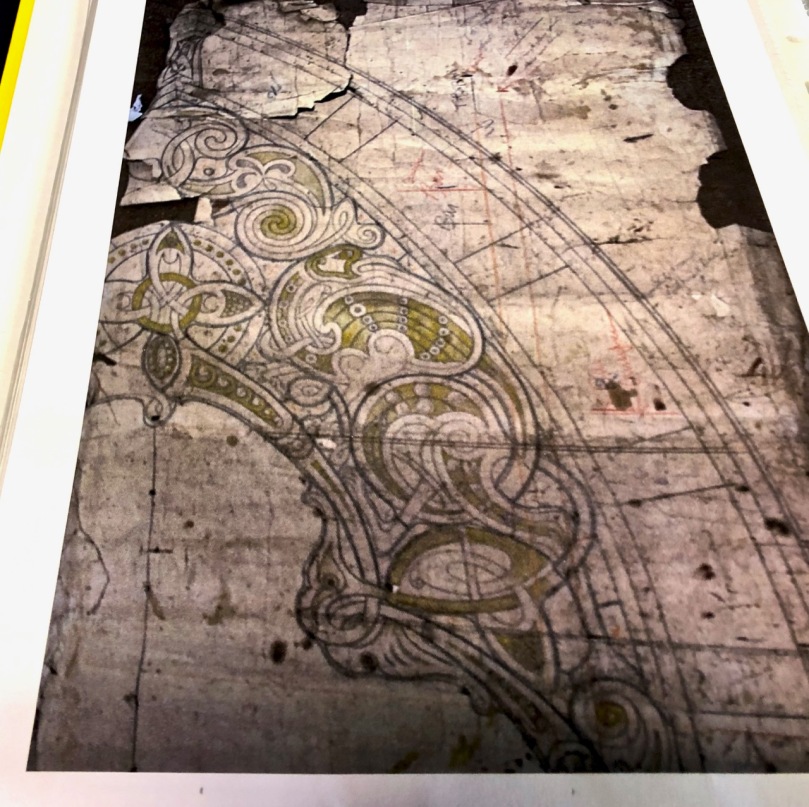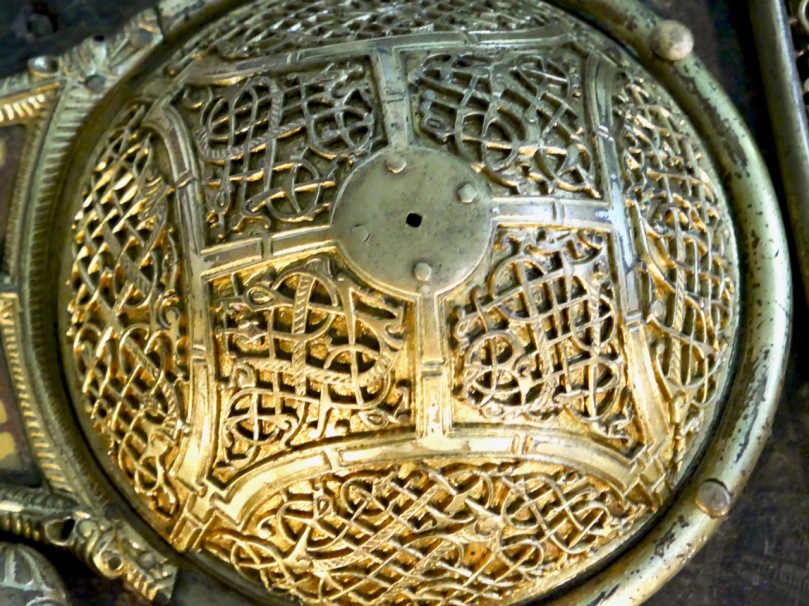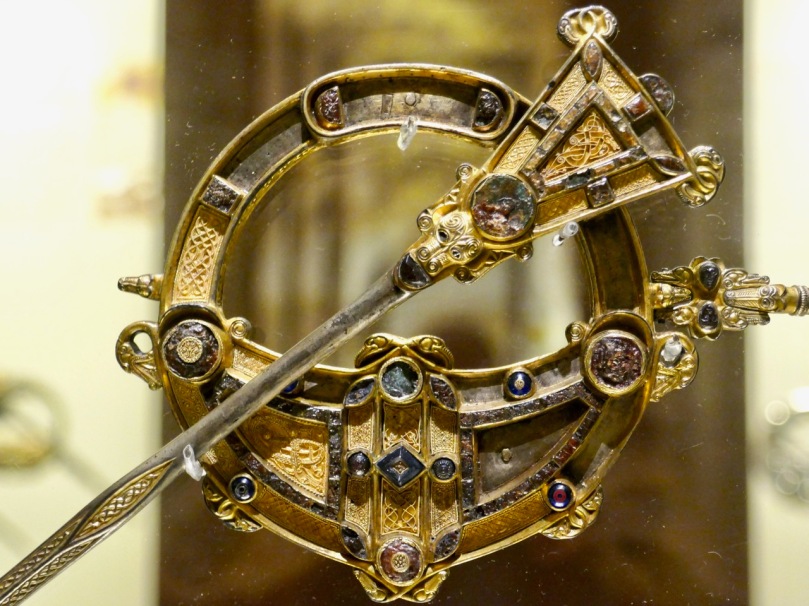In Part 1 I laid out the background to the Watsons of Youghal Revivalist-style windows, a design innovation for which they should be particularly celebrated. In this post I will provide further examples and tell you where you can see some.
The Watson Archive is housed at the Crawford Gallery in Cork. In it are original cartoons showing the careful working out of interlace patterns and of lettering styles. Since these cartoons are on long pieces of paper which remained rolled or folded in storage for many years, they are in fragile condition and therefore what one consults in the Crawford Archive is the file of photographs of these papers. While not ideal, this at least allows serious students of stained glass to see some of the original work upon which the windows were assembled. There are also smaller drawings and paintings – these were done as original designs from which the cartoons could be drawn and from which the colours could be worked out.
It’s a real thrill to come across a window that is based on one of those designs: see above and below for a perfect match! Incorporation of interlacing can also help to identify an un-signed window as being a Watson: it was what set them apart, when the figures themselves – the saints or angels – might be well-nigh indistinguishable from those of other stained glass manufacturers.
Interlacing is the preferred word for the complex looping and braiding of ribbons, which twist in and out and around each other and often end in the head of a fantastical animal. Artists studied the Book of Kells and other illuminated manuscripts, copied the elaborate decorations and eventually figured out their own designs. Just walk through any older cemetery in Ireland to see the craftsmanship with which many crosses were carved with interlace motifs. So it was with Watsons: they became expert at fitting and filling spaces in a window with Revivalist designs.
One of the best places to see Watson Revivalist windows, because it’s a small space and you can get close to the windows, is the Oratory at Gougane Barra. The vision for the building was that of Fr Patrick Hurley who developed the ‘ancient’ monastic settlement on the island, a scholarly man well versed in the Revivalist art and literature of the period who specified that the oratory itself would be built in the Neo-Romanesque style based on 12th century Irish churches such as Cormac’s Chapel (see this post for more on this). In the Oratory all the windows except a Marian image depict Irish saints, some of whom are local to Cork (Finbarr [above], Fachtna [below], Gobnait and Eltin).
Another West Cork church with Watson Revivalist windows is in Ardfield, south of Clonakilty. I used some of these in my Symbols and Stories post so take a look at those now. Note that, in contrast with the Gougane Barra Oratory, the iconography in Ardfield is essentially International-Catholic (St James, Jesus, Mary), very much in line with the Devotional Revolution which I described in my post Saints and Soupers: the Story of Teampall na mBocht (Part 7, the New Catholicism). Instead of repeating the Ardfield images here I will send you instead to the little country church in Castletown-Kinneagh, near Enniskeane, and one of my favourite windows – the Infant of Prague. In the extensive renovation of this church the parishioners, ably led by Fr Tom Hayes, worked hard to save this window from a porch which had to be demolished and re-located it in a light box inside the church. While not perfect for back-lighting, this has the great advantage of allowing the viewer to get really close to the window to observe the painting techniques and the details.
Next we will stop by St Ita’s church in Gortroe, near Youghal. Here you will find one of Watson’s Revivalist windows dedicated to that same Blessed Thaddeus McCarthy (below) about whom Fr Hurley wrote in the Journal of the Cork Historical and Archaeological Society and whose travails I described in my Post Thaddeus McCarthy, The Bishop Who Never Was. In the sanctuary is a three light window, the Sacred Heart flanked by Thaddeus and St Ita, while a Lourdes window occupies the south wall (a detail from that window is my lead image in this post).
Protestant churches were also attracted to Revivalist touches and one of the most interesting windows I’ve seen is in St John’s Church of Ireland in Knight’s Town on Valentia Island in Kerry. The two light window depicts the angels of Prayer and Praise, with book and harp. The angels are beautiful if over-familiar depictions, but it is the surround that shows how Watsons worked hard to customise windows according to the wishes of the clients.*
The windows commemorate James and Anne Graves. James Graves was the first Superintendent of the Anglo-American telegraph station on Valentia and he held the post for forty years. Accordingly, the framing surround of each window shows not only nicely worked-out interlace but the telegraph cable, punctuated by cross sections of that cable in red and green. Marine rope, telegraph poles and ceramic insulators also make an appearance, and the international telegraph alphabet is represented by black dots on a white background. The window was executed in 1912 and cost thirty five pounds.
So far I have illustrated this post from windows in small churches, but the very large Catholic Church of St Carthage in Lismore, Co Waterford, has several very fine Revivalist windows. Some are credited to Cox and Buckley and were completed in the 1890s; others were done after the company had changed its name to J Watson and Co. The church itself, in a flamboyant Lombardo-Romanesque style, is well worth a visit and the windows certainly enliven the interior. The iconography is a mixture of International-Catholic and Celtic-Revival/local iconography, with, for example, the Archangel Michael and St Carthage (see Part 1) side by side.
I included a detail from the Vision of St Ita window in Part 1, but it’s worth having a look at more of that window. The end of the nineteenth century saw the publication of many texts related to Irish saints – translations from Irish by such scholars as Whitley Stokes (see my post on The White Hound of Brigown) and Canon John O’Hanlon – and these became the religious equivalent of the stories of Finn McCool, Cuchulainn and the great Irish mythology cycles as written by Standish O’Grady and others at the time. St Ita was the foremost female saint of Ireland after St Brigid, and she is traditionally thought to have come from Waterford. She was given to visions and raptures and this is what is depicted here. And just look at those wonderful birds in the canopy above her head.
This demonstrates the popularity of these hagiographies with Irish Catholics and their clergy at the time – the artists responsible for these windows had to make sure they were well read on the lives of Irish saints. Both the Columcille window (above) and the Patrick window (below) exuberantly display their artist’s knowledge of the lives and deeds of these saints as well as their immersion in all the tropes of Celtic Revival imagery (wolfhound, anyone?).
The Rose Window has a panoply of Irish Saints (including Saint Otteran, Patron Saint of Atheists!) each one occupying one of the rays of the rose with cherubs encased in interlace. As they say in property ads – must be seen to be appreciated.
My final window astounded me when I first saw it – in fact I think it was my introduction to Watson’s use of interlace and it really is a virtuoso performance. I’ve used the bottom panel from it further back in the post to demonstrate how a cartoon ends up as a window, but the whole window deserves pride of place. It’s in the Catholic church in Inchigeelagh, Co Cork, and so we have circled back again to St Finbarr of Gougane Barra – an excellent place to stop.
I’ve included illustrations in this post from Cork, Kerry and Waterford but I would be interested to hear from anyone who has found Watson Revivalist windows anywhere.
Part 1 of this post is here




























